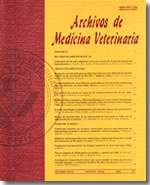Effect of a feed supplementation during the mid-lactating period on body condition, milk yield, metabolic profile and pregnancy rate of grazing dual-purpose cows in the Mexican humid tropic
Main Article Content
Abstract
Forty-eight grazing mid-lactating anoestrous dual-purpose cows were used to determine the effect of feed supplementation (FS) on body condition score (BCS), milk yield, metabolic profile and pregnancy rate in the dry (DS, n= 24) and rainy (RS, n= 24) seasons in Mexico. Half of the cows received FS with 19% crude protein from days 0 to 45. On days 0 and 45 BCS was assessed in all cows, and blood samples were collected to determine the serum concentrations of some metabolites. Milk yield was individually recorded from days-7 to 45 (day 0 = start of the FS period). On day 10 all cows were induced to oestrous with norgestomet and then artificially inseminated. BCS, serum albumin concentration and pregnancy rate were higher (P < 0.05) in DS. Milk yield and serum inorganic phosphorus concentration were not affected (P > 0.05) by FS or season of the year. Serum total protein was higher (P < 0.05) on day 0 in cows receiving FS in DS. Serum urea was lower (P < 0.05) on day 45 in cows without FS in DS, but was higher on day 45 in cows with and without FS in RS (P < 0.05). Serum copper and zinc were higher (P < 0.05) in RS, and serum zinc was also higher (P < 0.05) on day 45 in cows with and without FS in DS. In conclusion, FS affected serum concentrations of total protein, urea and zinc, whereas season of the year affected BCS, serum concentrations of albumin, copper and zinc and pregnancy rate.

